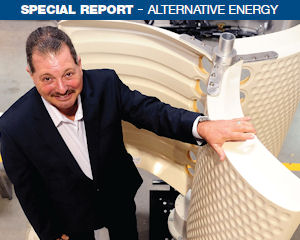Wind mills date back to ancient times, but once the Industrial Revolution arrived, small structures gave way to large ones that could saw wood and even make gun powder. Now, a Camarillo company is developing a small-scale windmill that it hopes will become as commonplace as the electric meter. Sauer Energy Inc. makes a product called the WindCharger, a roof-mounted vertical wind turbine that needs little more than a five-and-a-half-foot radius of space and five miles-per-hour wind to begin generating electricity. “Our goal is to show the average homeowner that they can save 20 to 25 percent of their energy bill,” said Chief Executive Dieter Sauer. “It’s designed to be able to work in even low wind conditions. It’s something they can see.” To begin production of WindChargers, Sauer obtained a $15 million line of equity this month from Eclipse Advisors LLC, an affiliate of New York institutional investment firm Central Park Financial LLC. However, the technology has yet to be tested in the market and so far, sales have been weak in urban areas. Government incentives also have been spotty. “The types of places where they are sold would most commonly be rural and some outer suburban areas,” said Larry Sherwood, executive director of the Small Wind Certification Council, a Denver trade group. “Incentives for wind are really inconsistent.” In 2007, Sauer founded the company in Nevada City. He worked with several engineers, finally fixing on the current design. Sauer relocated to Southern California with his wife, Ana, in 2009, thinking that the market for wind power would be greater in the region. The company first operated out of multiple locations in the Valley area before consolidating in its new facility in Camarillo in August. The WindCharger is a vertical axis wind turbine, which means that it sits on a rotator that is vertically affixed. Traditional wind turbines, including the tall ones often seen in wind farms, are centered around a horizontal rotation. Critics of vertical models say they are less efficient. But Sauer says the turbine, which is designed to be roof mounted, is capable of producing enough energy to cut a home’s use of grid energy by 20 percent. The turbine begins generating electricity when winds rise to just five miles-per-hour. Energy can be returned to the grid when it is not needed, providing customers discounts on utility bills. The turbines cost $8,000, which Sauer says can be recouped in three years after state rebates. “In California, after rebates, the cost is about $1,100,” he said. “You can see the return. You can see lower utility bills immediately and it has a life expectancy of 50 years.” Making it to market The company went public in a forward merger in 2010, after it was acquired by BCO Hydrocarbon Ltd., a Clyde Hill, Wash. natural resources exploration company. Funds raised from share sales, in addition to private investments and the line of equity have moved the company to the manufacturing stage. Shares trade over the counter at just around a quarter per share. The company has entered into an agreement with Greenville, Pa. manufacturing firm VEC Technologies Inc. to produce the blades of the turbines. The blades, made from lightweight composite material similar to a boat hull, will be shipped back to Camarillo for assembly by the team recently hired to staff the warehouse. Distributors have been signed, and installation training will begin in the first quarter of next year, according to Sauer. “We’re looking at spring for the first deliveries,” Sauer said. In addition to the WindCharger, the company is working on a second product called the Helix Wind Turbine. In May, Sauer Energy spent $1.5 million to purchase the technology of Helix Wind Corp., a defunct San Diego competitor that developed sleek five-foot tall vertical sails. The Helix-designed turbine differs from the WindCharger in that its tall, slender design means that it can be mounted either on the side of a building or on top. While this gives it an aesthetic advantage, it means that it has less opportunity for wind to hit the turbine. Sauer hopes to begin shipping the Helix model by the middle of next year. Vertical wind technologies have not taken off, partially because experts say the technology simply produces far less electricity than traditional horizontally mounted ones. “We have not yet certified a vertical turbine,” said Sherwood. “But I wouldn’t say that’s not because they can’t work.” Sauer believes that the set-it-and-forget element of the turbines, and the fact they can generate power when the sun fails to shine, will attract home and business owners who have considered solar panels. This story has been corrected. An earlier version misstated the cost of the turbines and the acquisition cost of Helix Wind.
